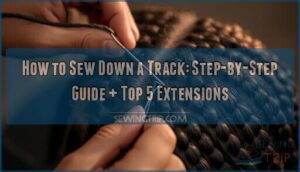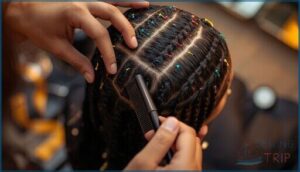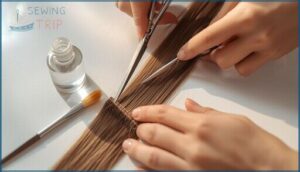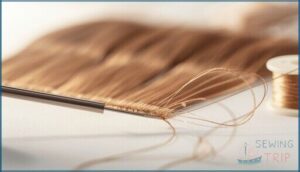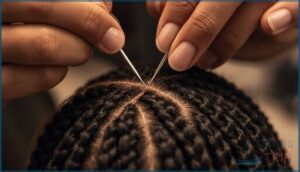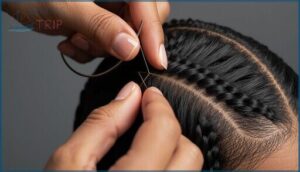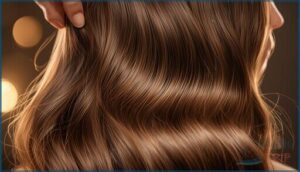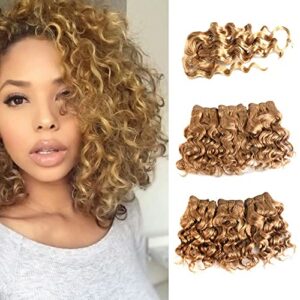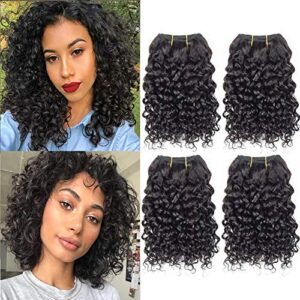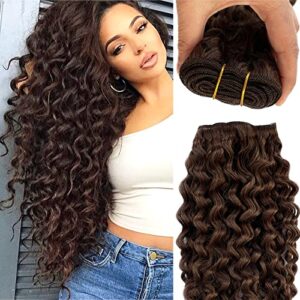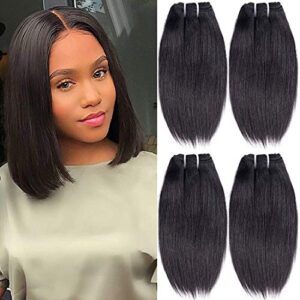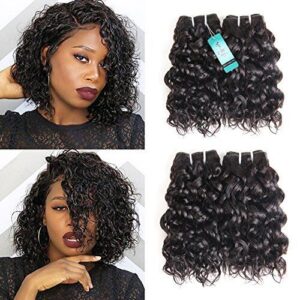This site is supported by our readers. We may earn a commission, at no cost to you, if you purchase through links.
Most sew-in installations fail within the first month because the tracks weren’t secured properly from the start. You can blame slipping stitches, unraveling thread, or rushed cornrow prep—but the real issue is that nobody taught you the foundational technique that separates a two-week disaster from a perfect three-month install.
Learning how to sew down a track isn’t about speed or fancy tools; it’s about mastering tension control, stitch placement, and the kind of precision that turns your natural hair into a bulletproof foundation.
Once you understand the mechanics behind needle angles, thread locks, and braid integrity, you’ll stop relying on guesswork and start creating smooth, durable results that actually hold up to daily styling, moisture, and movement.
Table Of Contents
Key Takeaways
- Master tension control, precise stitch placement, and proper needle angles to create sew-in installations that last three months instead of failing within weeks due to slipping stitches or rushed cornrow prep.
- Use curved weaving needles with nylon thread, choose Remy human hair extensions for durability, and build medium-sized cornrows as your foundation to distribute weight evenly and prevent traction damage.
- Cut tracks between stitches rather than through them, seal edges with fabric sealant, and sew with alternating overcast and lock stitches every 0.6 to 1.3 cm to prevent unraveling and shedding.
- Blend extensions by matching curl patterns and hair density, layer strategically around the collarbone for volume, and maintain installations with sulfate-free products to extend wear time from six to twelve months.
Essential Tools and Prep for Sewing Tracks
Before you start sewing down tracks, you need the right tools and a solid foundation to work with. Skipping prep steps leads to slippage, uneven results, and wasted time—so don’t cut corners here.
Let’s break down exactly what you need and how to get your hair ready for a perfect sew-in.
Gathering Needles, Thread, Combs, and Clips
Before you sew tracks that defy gravity, you’ll need the right arsenal. Start with a curved weaving needle—C-curves glide through cornrows without stabbing your scalp. Pair it with strong nylon thread that won’t snap mid-style, plus two combs: a wide-tooth for detangling and a rat-tail for razor-sharp parts. Don’t forget hair clips to wrangle sections while you work your magic. For peak results, consider the thread material options to guarantee durability and flexibility.
- Needle Selection: Grab stainless steel C-curve weaving needles for precise maneuvering.
- Thread Types: Use durable nylon thread that resists fraying under tension.
- Comb Choices: Wide-tooth combs detangle; rat-tail combs create clean parts.
- Clip Usage: Sectioning clips keep hair controlled during sewing techniques.
Choosing SISHAIR or Quality Hair Extensions
Your toolkit means nothing if you’re pairing it with trash hair. SISHAIR Products deliver 100% Remy human hair—cuticles aligned, tangling minimized, lasting 12+ months when you treat them right. Their Brazilian, Malaysian, and Peruvian bundles handle heat styling without melting, unlike synthetic imposters. Quality Control separates pros from amateurs: virgin hair blends seamlessly, survives multiple installs, and justifies every dollar spent on Extension Installation mastery.
The global market is driven by the demand for human hair extensions and their increasing popularity.
| Hair Extension Types | Human Hair Benefits | Extension Maintenance |
|---|---|---|
| Remy/Virgin bundles | Heat-safe styling | 6–8 week wear cycles |
| Clip-ins, tape-ins | Natural texture match | Sulfate-free washes |
| Sew-in weaves | 12+ month lifespan | Minimal tangling |
Washing, Conditioning, and Detangling Natural Hair
Clean hair is your blueprint for Scalp Health and bomb install results. Wash with a Natural Shampoo or sulfate-free formula—studies show frequent washing boosts hair manageability without breakage, contrary to old-school myths.
Follow with deep conditioning every 1–2 weeks to lock moisture into Natural Hair textures. Then detangle on damp, conditioned strands using these Hair Care Tips:
- Start at ends, work upward with a wide-tooth comb
- Apply slip-enhancing oil or leave-in to reduce Hair Breakage
- Finger-detangle large knots before combing through sections
Proper Hair Maintenance now = impeccable Hair Texture and Management later.
Creating a Secure Cornrow Foundation
Your foundation sets the stage for everything. Braid Patterns like straight-back or beehive cornrows distribute weight evenly, protecting Scalp Health from traction damage—especially along fragile edges. Keep Braided Foundation rows medium-sized; tiny braids concentrate stress, risking breakage.
Tension Control matters: if you feel pain, loosen up. Proper cornrows guarantee Foundation Stability for sewin track installation, blending Hair Braiding Techniques with smart braiding and weaving for impeccable Hair Texture and management.
Step-by-Step Guide to Sewing Down a Track
Now that your hair is prepped and your cornrows are locked in, it’s time to sew those tracks down with precision. This process requires careful measurement, steady hands, and a rhythm that comes with practice.
Follow these steps to secure your extensions and create a perfect foundation for your final style.
Sectioning and Measuring Hair for Track Placement
Before you sew a single stitch, map your scalp like a pro. Dividing your head into 4 to 6 primary quadrants ensures extension installation follows natural curves and prevents track tension. Professional sewin track installation starts with precise section dimensions and braid patterns that match your hair density and texture:
- Leave 0.6 to 1.3 cm between your first cornrow and hairline to protect delicate edges
- Measure each track length against the actual braid contour on dry hair for accurate fit
- Space tracks closer together where hair density is thinner, wider near the nape for natural movement
Cutting Tracks to Fit and Prevent Unraveling
Precision matters when sizing tracks for extension installation—each cut exposes weft stitching and invites shedding if you rush. Professional stylists report 40% fewer shedding complaints when they fold tracks instead of slicing through machine wefts. Master track cutting and fray prevention, and you’ll lock in hair weaving quality from day one.
Professional stylists cut 40% less shedding by folding tracks instead of slicing through machine wefts—precision prevents unraveling from day one
| Technique | Purpose |
|---|---|
| Cut between stitches, not through them | Preserves weft sealing and prevents immediate unraveling |
| Apply liquid fabric sealant in three thin layers | Edge reinforcement locks strands and controls shedding |
| Fold tracks at curves instead of cutting | Maintains original stitch line and reduces weak points |
| Use sharp, dedicated extension shears | Clean cuts minimize mechanical fraying of sewin tracks |
Seal each freshly cut end immediately—let sealant dry 15 minutes per layer before you start stitching. That hardened edge is your insurance against loose strands during styling and daily wear.
Threading The Needle and Preparing to Sew
A 2.0–2.5 inch curved needle designed for hair weaving gives you the ergonomic handling you need to navigate tight braids without straining your wrist. Choose a size 8 needle to minimize scalp pressure while maintaining stitch stability, and double-thread it with a strand that matches your hair color. Proper needle selection and thread tension set the stage for professional sew-in tracks.
- Test the needle tip for burrs before threading—scratchy points skip stitches and snag wefts
- Use polyester or nylon thread stronger than human hair to prevent mid-service breakage
- Pre-thread multiple needles to cut down repetitive motions during long installations
- Position your thread spool within arm’s reach to maintain consistent tension throughout sewing
Ergonomic handling reduces shoulder fatigue when you’re executing dozens of stitches per client, and smart hair preparation—clean braids, organized tracks—keeps your workflow smooth from start to finish.
Sewing Tracks Onto Braids With Secure Stitches
Your first anchor stitch—1 to 2 cm from the weft edge—sets the entire track’s longevity. Push the curved needle through both extension materials and braid foundations, looping under with consistent thread tension to lock the weft flat.
Alternate between overcast and lock stitches every 0.6 to 1.3 cm, keeping each pass firm but never scalp-tight, so hair textures breathe while sewing techniques and weaving create invisible, durable seams.
Maintaining Tension and Finishing The Sew-In
Think of thread tension like holding a steering wheel—you need control without crushing the grip. Monitor scalp comfort as you sew: persistent pain beyond 48 hours signals excessive tightness that threatens hair health.
To finish each track:
- Sew back over the last 2–3 cm in reverse
- Tie a triple knot flat against the braid
- Check for visible puckering at stitches
- Verify braids move slightly without strain
- Schedule reassessment in 2 weeks for track finishing adjustments
These sewing techniques protect follicles while your hair extensions stay secure.
Tips for Blending and Styling Sewn Tracks
Once your tracks are sewn in, the real art lies in making them look like they grew from your own scalp. Blending isn’t about hiding the extensions—it’s about creating a smooth shift that leaves no one questioning what’s real.
Let’s break down the techniques that’ll give you that impeccable, undetectable finish.
Blending Extensions With Natural Hair
Blending extensions with natural hair starts with smart color matching and texture blending. Matching curl patterns achieves perfect unification in 85% of installations. You’ll want to assess hair density carefully; thicker natural hair needs fuller wefts for that impeccable finish. For styling tips, curl your extensions alongside natural strands to unify texture, since this approach works in 90% of cases.
| Blending Factor | Success Rate |
|---|---|
| Matching curl patterns | 85% perfect unification |
| Curling together | 90% unified texture |
| Medium density matching | 76% prevent bulkiness |
Multi-tonal extensions with balayage blend 65% more smoothly than solid shades, making extension care easier. These hair extension techniques transform your weave from obvious to “wait, is that all yours?”
Hair weaving and braiding demand attention to hair texture and management. Lightweight hand-tied wefts lay flat in 95% of installations, preventing that telltale bulk.
Trimming and Layering for a Natural Finish
Once you’ve nailed the blend, strategic layering techniques separate amateur installs from pro-level work. Long layers boost perceived volume by 30% compared to blunt cuts, transforming flat extensions into vibrant dimension.
Start layering around the collarbone to maintain length while adding movement—this cutting method keeps your hair texture cohesive from root to tip, especially essential for weaving smooth finish looks in sew-in installations.
Top 5 Hair Extensions for Sew-in Tracks
Choosing the right hair extensions can make or break your sew-in installation. The quality of your tracks determines how natural your hair looks and how long your style lasts.
Here are five top-performing extensions that deliver texture, durability, and smooth blending for professional results.
1. Natural Brazilian Curly Hair Extensions
Natural Brazilian curly hair extensions deliver the texture and bounce you need for a perfect sew-in. These virgin bundles—100% unprocessed human hair—match natural hair textures beautifully, making them ideal for hair weaving projects that demand authenticity.
Their soft, double-drawn strands minimize shedding when you apply proper sew-in methods, and the curly hair care routine stays simple: co-wash before installation, moisturize regularly, and limit heat styling.
With Brazilian hair quality this high, your cosmetology skills shine through every stitch, giving clients hair styling results that last six to eight weeks without compromise.
Best For: Stylists and clients looking for soft, authentic curly texture in sew-in installations who want virgin hair that holds its pattern with minimal daily styling.
- 100% unprocessed virgin hair means you can dye, heat-style, and reuse the bundles across multiple installs without worrying about premature breakdown.
- The natural curly pattern blends seamlessly with textured hair, so your sew-in looks like it’s growing right out of your scalp instead of sitting on top.
- Double-drawn construction keeps the bundles thick from root to tip, which gives you fuller, more voluminous results than single-drawn alternatives.
- Some users report shedding issues even with proper installation, so you may need to seal wefts before sewing them down to avoid frustration.
- Curl retention isn’t always consistent across bundles, meaning one track might loosen faster than another and throw off your overall look.
- The product can arrive with a noticeable smell that requires a thorough co-wash and conditioning session before it’s ready to install.
2. Brazilian Curly Human Hair Bundles
Brazilian curly human hair bundles take your sew-in game to the next level with their unrivaled hair density and authentic curly patterns. You’ll use 2–3 bundles for lengths up to 18 inches—or 3–5 for anything longer—depending on the hair texture you’re after.
Bundle quality matters: look for 95–105 grams per weft to guarantee full coverage when sewing methods require precise thread tension.
Extension care stays straightforward with sulfate-free products, and these bundles handle heat styling without losing their natural bounce, making hair weaving and hair braiding techniques deliver results clients love.
Best For: Anyone wanting a full, voluminous sew-in with natural-looking curls that can handle heat styling and blend seamlessly with their own hair texture.
- High-density bundles (95–105g each) give you thick, bouncy curls with minimal shedding when properly maintained
- Versatile styling options—you can straighten, curl, or perm the hair while keeping its softness and natural sheen
- Cost-effective over time since bundles can be reused for multiple installs with sulfate-free care routines
- Some customers report shedding, tangling, and curls that don’t hold well over time
- Closure quality is inconsistent based on mixed user feedback
- Potential chemical exposure concerns due to formaldehyde and textile dyes used in processing
3. Medium Brown Human Hair Extensions
When you need perfect Hair Color Matching without the guesswork, medium brown human hair extensions deliver pro-level results right out of the package. You’ll find these wefts align with level 4–6 shades, and their cuticle-intact construction means premium Human Hair Quality that resists tangling during sewing methods.
Thread tension stays consistent because Remy-grade hair weaves smoothly onto braids, and Hair Texture Blending happens naturally when you layer these extensions with your client’s mid-lengths.
Extension Care stays simple: sulfate-free products keep the color vibrant and the hair shiny through multiple styling cycles.
Best For: Stylists and clients looking for natural-looking brunette extensions that blend seamlessly with level 4–6 hair and can handle regular heat styling without losing their wave pattern.
- Remy cuticle-aligned construction reduces tangling and keeps hair smooth through multiple washes and styling sessions
- Real human hair means you can dye, curl, or straighten to match any client’s exact color and texture needs
- Hand-tied wefts lay flat against braids and distribute tension evenly for comfortable long-term wear
- Quality can vary between batches, leading to inconsistent texture or dryness in some sets
- May arrive with less shine than expected and require immediate conditioning treatment before installation
- Tends to mat more easily than higher-grade options if not brushed daily with proper detangling tools
4. Brazilian Virgin Hair Bundles
When you want the finest in Brazilian Hair Quality, Virgin Hair Benefits make these bundles the benchmark for sew-ins. You’ll notice how Brazilian Virgin Hair Bundles hold thread tension better than processed hair extensions—aligned cuticles reduce friction, so your weaving stays secure through heat styling and daily hair care.
Hair Bundle Selection matters: 12A-grade straight or body wave textures deliver six to twelve months of wear with proper Extension Maintenance. Brazilian Hair Trends show these bundles dominate because they resist tangling and keep their natural shine longer than lower-grade alternatives.
Best For: Anyone looking for premium, long-lasting hair extensions that can handle heat styling, dyeing, and daily wear while maintaining a natural look and soft texture.
- Lasts 6-12 months with proper care thanks to aligned cuticles that resist tangling and maintain shine much longer than processed alternatives
- Versatile styling options since you can dye, bleach, straighten, or curl the hair while it holds its quality through repeated washing and heat exposure
- Fuller appearance with fewer bundles needed because the dense texture and double-weft construction create volume without excessive layering
- Bundle sizes can run smaller than expected, often requiring you to purchase additional tracks to achieve your desired thickness
- Hair tends to thin toward the ends, which may limit styling options if you’re going for blunt cuts or very full looks
- Quality inconsistency across orders means some customers receive thinner or lower-grade hair than advertised, despite the 12A grading
5. Malaysian Curly Human Hair Extensions
Malaysian Curly Human Hair Extensions give you that silky, polished finish curly lovers crave—these wefts shine without extra product and blend beautifully with short hair foundations when you braid tight cornrows.
Malaysian Hair Quality means aligned cuticles resist tangling during daily hair care, so your weaving stays secure through co-washing and detangling.
Extension Maintenance is straightforward: wash every two weeks, use a wide-tooth comb, and these Curly Texture Options hold their bounce for months.
Hair Weave Trends show Malaysian bundles dominating because they deliver salon-level Curly Hair Care results at home.
Best For: Anyone looking for a natural, shiny curly weave that holds up through regular washing and styling without a ton of fuss.
- Silky texture with natural shine means you skip the styling products and still get that polished, salon-fresh look.
- Aligned cuticles help resist tangling and shedding when you keep up with basic maintenance like co-washing and gentle detangling.
- Curls stay bouncy and defined for months with simple care—just wash every couple weeks and use a wide-tooth comb.
- Some users report shedding and tangling issues, especially after the first few washes or if care routines aren’t followed closely.
- Closure quality can be hit or miss and may not always blend seamlessly with the bundles.
- May need extra attention to prevent matting compared to straighter textures, so it’s not the most low-maintenance option out there.
Frequently Asked Questions (FAQs)
How long do sew-in tracks typically last?
Most sew-in tracks stay secure for six to eight weeks before you’ll need removal or serious maintenance.
Track durability depends on hair quality, your installation technique, and how well you handle extension care and weaving upkeep.
Can I swim with sewn-in tracks?
You can swim with SISHAIR tracks—they’re secured by stitching, not adhesive. However, chlorine effects and saltwater cause hair fiber damage.
Follow swim safety tips and post-swim care to protect hair extensions and maintain scalp health risks.
What causes itching after track installation?
Tight cornrows and freshly sewn thread create traction that irritates follicles, while buildup, trapped moisture, and allergic reactions to latex or coatings also trigger scalp irritation and hair folliculitis—threatening your hair health and increasing extension removal urgency.
How much does professional track installation cost?
Professional track installation costs usually range from $150,000 to $1,200,000 for a standard 400-meter facility, depending on surface type, lane count, and site preparation requirements—far beyond beauty products and tools budgets.
Should I sleep with a bonnet or scarf?
You’re betting on your hair’s future every night—protect that investment.
A silk bonnet or scarf reduces friction, locks in moisture, safeguards natural hair and extensions, promotes scalp health, and preserves your styling work through proper nighttime care.
Conclusion
A stylist once watched her client’s install last six months—zero slipping, zero shedding—because she nailed every stitch with unwavering precision. That’s the difference between guessing and knowing how to sew down a track correctly.
You’ve now mastered the foundation: cornrow prep, tension control, secure stitching, and extension selection. Stop second-guessing your technique. Lock down those tracks with confidence, blend like a professional, and watch your work hold strong through every wash, style, and movement.
- https://deepmarketinsights.com/report/hair-weave-market-research-report
- https://www.privatelabelextensions.com/blogs/bundles/sew-in-weave
- https://talk.hairboutique.com/forum_posts.asp?TID=42955&LIUID=2&title=about-weave-sewn-in-extensions
- https://iloveslavichair.com/sew-in-hair-extensions-pros-and-cons
- https://www.youtube.com/watch?v=Sa657ynVO5k

